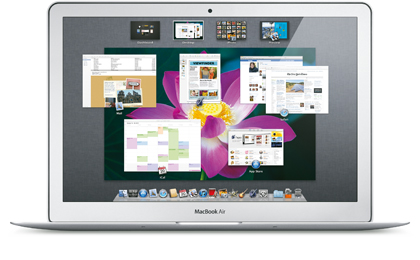OS X 10.7 Lion guide: get started with Lion today
Get your Mac ready, feature details and multi-touch explained

UPDATE: Check out our hands on OS X Lion review.
The eighth release of OS X - OS X 10.7 Lion - is packed with over 250 new features, many of which were inspired by iOS. With Lion, Apple takes note of lessons learned developing the engine that powers the iPad, iPhone and iPod touch, and brings them to the Mac.
Take LaunchPad. You can tell at a glance Lion's new application launcher is based on the iOS home screen, with its application icons arranged in a user-modifiable grid. Lion brings full-screen apps to Mac OS too.
At the push of a button, your application fills the screen, offering the same distraction-free usability you get with an iOS device. Mail, Apple's respected email client, also benefits from qualities and features developed for the small-screen version.
But it's not all about features gleaned from iOS; Mac OS has also learned a few new tricks of its own. Mission Control brings together OS X's Spaces, Dashboard and Exposé in one easy-to-use bird's-eye view showing everything that's currently running on your computer.
AirDrop lets you share files over WiFi, and Resume starts up your Mac in exactly the same state it was in when you shut down, with the same applications open, its windows positioned as before and even highlighted text restored.
With all these fine features on offer, and an asking price of just £21, most Mac owners are keen to upgrade. In this feature, we'll show you how to get your Mac ready for Lion, and how to use some of its key functions.
Get daily insight, inspiration and deals in your inbox
Sign up for breaking news, reviews, opinion, top tech deals, and more.
We're currently putting the new OS through its paces and we'll have our in-depth Mac OS X 10.7 Lion review up soon.
Getting your Mac ready for OS X 10.7 Lion
After several months of tantalising previews, excited blogs and leaks from registered developers, you're just dying to get your hands on Lion. But can you run it? Is your trusty old machine prepared for this latest version of OS X, and if it isn't, what can you do? It's time to get your Mac ready for the upgrade.
If you're going to install OS X 10.7: Lion, your Mac must meet the operating system's minimum system specs. Naturally, you need an Intel processor. Support for PowerPC-based Macs was dropped with OS X 10.6: Snow Leopard, so an Intel-only Lion was inevitable.
Also inevitably, Lion makes greater demands on your computer than its predecessor. Snow Leopard could be installed on any Intel Mac, but with Lion, you must have a Core 2 Duo, Core-i series or Xeon processor. Intel Macs with Core Duo chips cannot run it. So if you own a PowerPC or a very early Intel model, you need to buy a new Mac.
Lion also needs more RAM than Snow Leopard, demanding 2GB against its predecessor's 1GB. Thankfully, upgrading your computer's memory is a fairly painless task, and as long as you buy from a third-party vendor, it doesn't have to cost a fortune.
To check how much RAM is currently installed and what processor you have, go to the Apple pull-down menu in the top-left corner of your screen, and select About This Mac. Instructions for fitting more memory can be found in your user manual or on Apple's support site. Make sure you follow the correct instructions for your model of Mac.
Installing OS X 10.7 Lion
Previous versions of Mac OS X installed from optical discs, or in the case of the recent MacBook Airs, flash drives. Lion takes a new approach. Instead of delivering the operating system on physical media, you download it from the Mac App Store.
Launched in January to great success, the App Store is now an integral part of Snow Leopard, but isn't compatible with older versions of OS X. This means if you're still running Leopard, or even Tiger, you must upgrade to Snow Leopard before you can install Lion.
The App Store was introduced to Snow Leopard with the 10.6.6 upgrade, so if you're running 10.6.5 or older, run Software Update or download the combo updater from Apple's support site. You can then purchase, download and install Lion direct from the App Store, which can be launched from the Dock, your Applications folder or from the Apple pull-down menu.
As Snow Leopard was so cheap, we doubt there are many Macs capable of running Lion that still using Tiger or Leopard. But if you're in this situation, you need to buy two operating systems to run the latest version of OS X; Snow Leopard for the App Store, then Lion. Not that this is a huge expense.
Snow Leopard sells for just £26, and Lion is even more affordable at a penny shy of £21. As older versions of OS X cost £89 for a single-user licence, the combined cost of Lion and Snow Leopard is not much more than half the price.
- 1
- 2
Current page: Getting your Mac ready for OS X 10.7 Lion
Next Page OS X 10.7 Lion multi-touch and Rosetta